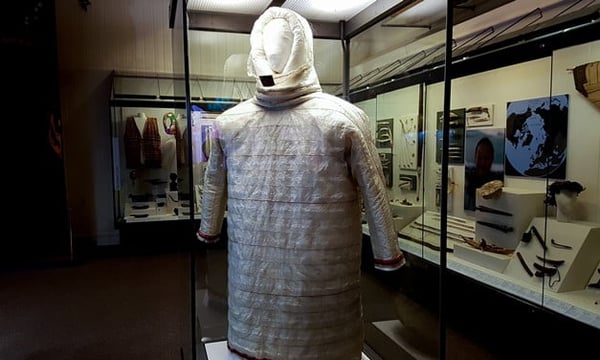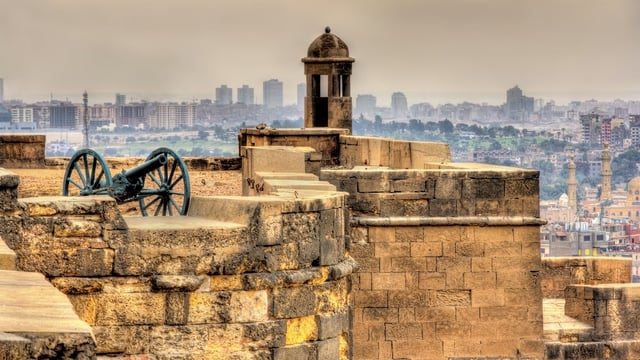- Beth Howell
- Last Checked and/or Updated 15 December 2021
- No Comments
- History with Kids
As you go around the museum, you will notice all sorts of different items on display. Some of them might seem quite odd to you! But clothes tell stories just like other objects do. Who wore that coat? Who made that hat? A piece of clothing always tells you something about the life of the person who wore it.
To find out more, let’s take a closer look at some of the more interesting, wacky and fantastic examples in the RAMM’s wardrobe.
Formal Gown, 1760/5
This huge dress was in fashion for most of the eighteenth century. Can you imagine wearing something as massive as this? It probably made walking through the door a bit difficult! Rich (or aristocratic) women would wear a big roll around their waist to make their dresses stand out, as well as wearing huge towering wigs on their heads. The bigger the dress, the more wealthy you were (or that’s what other people thought when they looked at you!) This dress was also made out of hand-painted Chinese silk, which was a very expensive material. Later, it was altered for a children’s fancy dress party. Would you wear something like this?
Victorian Hat, 1893/6
This unusual looking hat contains an ostrich feather, probably added by the maker, or milliner, to make it look more grand and expensive. Earlier in the Victorian period, women usually wore bonnets, but by the time this piece of clothing was made, bonnets were only really worn by older women or people in mourning, and hats like this were becoming a lot more fashionable. Hats told you a lot about how rich and trendy the wearer was. This one was made in Somerset by a very successful company called J. H. Holloway of Wells. Did you know that Wells is England’s smallest city, and contains England’s oldest street?
Ancient Greek Helmet, 2,500 years old
This is a ‘Corinthian’ type, and was found in Avida, near Greece. Though it might not look as colourful as your bike helmet, it’s still pretty amazing! It was made about 2,500 years ago by a master craftsman, and would have been shaped to fit the head of the person who wore it from a single sheet of bronze. As you can imagine, it was pretty difficult to look around or hear once you had it on. That’s because helmets like this were mainly made to protect warriors. In the middle of battle it was probably better not to hear everything that was going on anyway. Ancient Greece was made up of lots of different states that often fell out and fought against each other.
Parka, Made before 1869
This coat is known as a parka, and might look a bit like one you might have at home. This one was made before 1869 though, in the Aleutian Islands. Can you guess what it was made out of? This coat was created from the skin of a sea mammal, which made it waterproof, but also meant it tore very easily. Replacements could take a whole month to make – not an easy task! Coats like this were also very valuable, and were often traded or given as gifts to Europeans and Russians in the late 19th century. This parka is also decorated with human hair, which makes it a bit of an unusual present.
Octopus Bag, Collected before 1847
This bag looks a bit curious doesn’t it? It was found, and probably used, in Canada, and is known as an “octopus bag,” because of its eight pockets, or ‘tails.’ Each pocket would contain tobacco or personal medicine for the person who wore it. This bag was made from red trade cloth from Gloucestershire, and has been decorated with glass beads. Just like the person who owned it, it has been on a long journey! It was collected in Canada, but probably made somewhere in Europe. Do you think you could make a bag like this? What would you keep in it if you did?
Set of Rings, Mid 1900
This collection of rings was made in Oman in the late nineteenth century. Each ring is silver, and they all have different names:
jabiyrah (this goes on your thumb!)
shawahid (this is for your forefinger, or ‘pointer’!)
mahar (the second, or middle finger)
kanabir (your third finger, or ring finger)
khanafir (your little finger)
Do you think you can remember all those names? Test yourself and see!
Silk Bag & Beetle Decoration, About 1850
Can you see the green jewel-like decoration on this silk bag? Each of these ‘gems’ were actually made from beetle wings! In the nineteenth century, the Victorians used all sorts of materials for jewellery and decoration, including human hair! Beetle wings were very popular though because of the way they caught the light. When Ellen Terry played Lady Macbeth in 1888, her dress was made out of beetle wings. How would you feel owning a dress made from insects?
Samurai Armour, Made after 1500
It might not look like it, but all the pieces of this armour actually came from different sets! When warriors won bits of armour in battle, they would keep them and put them together to make a suit. This helmet, for example, doesn’t belong to the body of the armour. Once suits like this were all put together though, they probably still looked pretty terrifying to the enemy! Decoration was also added to make the warrior seem more frightening. That might not have been the case for the painted moustache though! Can you spot it on the facemask? Do you think it makes the armour look more or less scary?
Spirit costume, Collected in the late 19th century
This beautiful spirit costume was collected from the Congo by a man called Richard Dennett, who travelled a lot in Central Africa during the 19th century. Have you noticed that this costume has two faces? We aren’t completely sure, but we think this is because the people of the Kongo believed this spirt, known as a ndungu, could face the world of the living and the dead at once. The costume is made out of wood and hornbill feathers, a bird with a very large beak that can still be seen in the Congo today.
Which piece of clothing was your favourite? Did you spot anymore as you went around the museum? What do you think your clothes will say about you in the future?
Please note that the RAMM has a large collection, and to show it to its best advantage the objects on display are often subject to change. Happy clothes-hunting!






